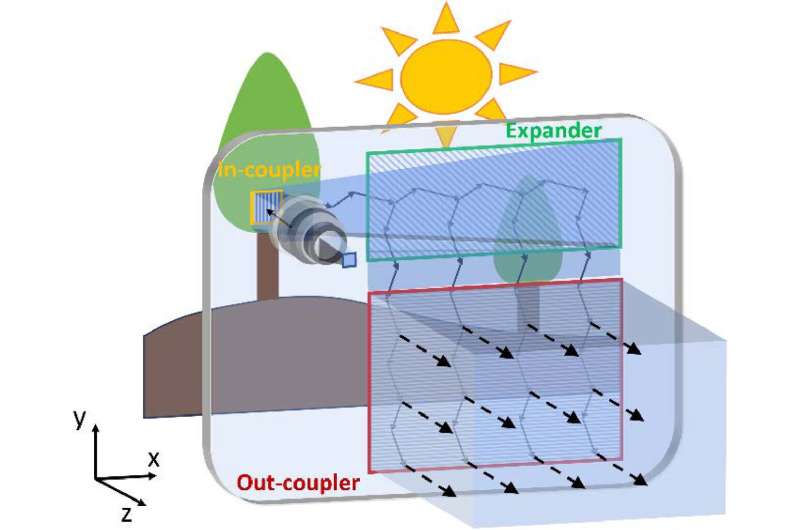Science
Researchers Enhance AR Glasses with Innovative Metasurface Design

A team of researchers from the University of Rochester has made significant strides in the development of augmented reality (AR) glasses by designing a new optical component that enhances brightness and image quality. This innovation could bring AR glasses closer to mainstream adoption, similar to the current ubiquity of smartphones.
In a study published on November 11, 2025, in the journal Optical Materials Express, lead researcher Nick Vamivakas highlighted the challenges faced by existing AR headsets, which often suffer from bulkiness, short battery life, and dim displays. “Many of today’s AR headsets are bulky and have a short battery life with displays that are dim and hard to see, especially outdoors,” Vamivakas stated. The newly developed technology aims to create a more efficient input port, making AR glasses brighter and more power-efficient.
Revolutionizing Image Clarity with Metasurfaces
The researchers focused on improving the waveguide in-coupler, the component responsible for injecting images from a micro-display into the lenses, which often leads to reduced brightness and clarity. By utilizing metasurface technology, the team replaced the single waveguide in-coupler with one that features three specialized zones made from metasurface materials. These ultra-thin materials allow for precise control over light, enabling enhanced performance that traditional optics cannot achieve.
“Metasurfaces offer greater design and manufacturing flexibility than traditional optics,” Vamivakas noted. The new in-coupler is designed to efficiently capture incoming light while minimizing loss, thereby maintaining the quality of the image. This research builds on earlier theoretical work, demonstrating that a multi-zone in-coupler provides the best efficiency and image quality.
The team utilized advanced fabrication techniques, including electron-beam lithography and atomic layer deposition, to create the complex nanostructures required for the metasurfaces. Vamivakas remarked, “This paper is the first to bridge the gap from that idealized theory to a practical, real-world component.”
Testing and Future Applications
To validate their design, the researchers tested each of the three metasurface zones individually before assembling the complete device. The testing involved measuring the total coupling efficiency across a horizontal field of view ranging from -10° to 10°. The results showed an average efficiency of 30%, closely aligning with the simulated average of 31%. However, at the field’s edge, a drop in efficiency was observed, attributed to the design’s high angular sensitivity and potential fabrication imperfections.
Looking ahead, the research team plans to apply their metasurface design and optimization framework to other components of the waveguide system. Their goal is to develop a fully integrated prototype that incorporates the in-coupler with a micro-display engine and an out-coupler. Additionally, they aim to expand the design to support full-color operation and improve fabrication tolerance.
For this technology to become commercially viable, the researchers emphasize the need for a robust manufacturing process capable of replicating the intricate nanostructures at a low cost. The advancements in metasurface technology may not only revolutionize AR glasses but also find applications in various compact optical systems, including head-up displays for automotive and aerospace industries.
As the research progresses, the potential for AR glasses to become a practical tool for everyday use grows, paving the way for a future where augmented reality is seamlessly integrated into daily life.
-

 Health2 months ago
Health2 months agoNeurologist Warns Excessive Use of Supplements Can Harm Brain
-

 Health3 months ago
Health3 months agoFiona Phillips’ Husband Shares Heartfelt Update on Her Alzheimer’s Journey
-

 Science3 weeks ago
Science3 weeks agoBrian Cox Addresses Claims of Alien Probe in 3I/ATLAS Discovery
-

 Science3 weeks ago
Science3 weeks agoNASA Investigates Unusual Comet 3I/ATLAS; New Findings Emerge
-

 Science3 weeks ago
Science3 weeks agoScientists Examine 3I/ATLAS: Alien Artifact or Cosmic Oddity?
-

 Science2 weeks ago
Science2 weeks agoNASA Investigates Speedy Object 3I/ATLAS, Sparking Speculation
-

 Entertainment4 months ago
Entertainment4 months agoKerry Katona Discusses Future Baby Plans and Brian McFadden’s Wedding
-

 World2 months ago
World2 months agoCole Palmer’s Cryptic Message to Kobbie Mainoo Following Loan Talks
-

 Entertainment3 months ago
Entertainment3 months agoEmmerdale Faces Tension as Dylan and April’s Lives Hang in the Balance
-

 Science2 weeks ago
Science2 weeks agoNASA Scientists Explore Origins of 3I/ATLAS, a Fast-Moving Visitor
-

 Entertainment4 months ago
Entertainment4 months agoLove Island Star Toni Laite’s Mother Expresses Disappointment Over Coupling Decision
-

 Entertainment3 months ago
Entertainment3 months agoMajor Cast Changes at Coronation Street: Exits and Returns in 2025









